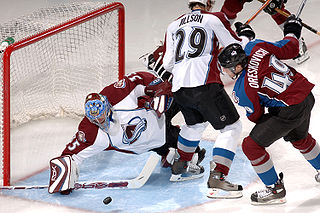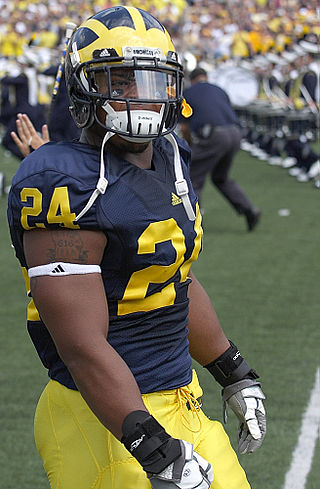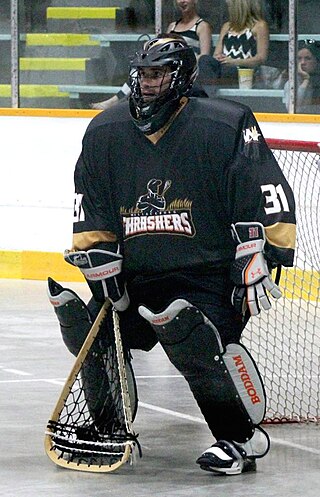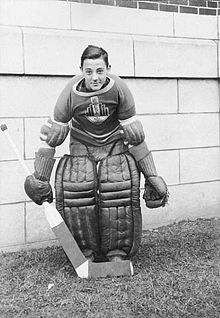
In many team sports that involve scoring goals, the goalkeeper is a designated player charged with directly preventing the opposing team from scoring by blocking or intercepting opposing shots on goal. Such positions exist in bandy, rink bandy, camogie, association football, Gaelic football, international rules football, floorball, handball, hurling, field hockey, ice hockey, roller hockey, lacrosse, ringette, rinkball, water polo, and shinty, as well as in other sports.

In ice hockey, the goaltender is the player responsible for preventing the hockey puck from entering their team's net, thus preventing the opposing team from scoring. The goaltender mostly plays in or near the area in front of the net called the goal crease. Goaltenders tend to stay at or beyond the top of the crease to cut down on the angle of shots. In the modern age of goaltending there are two common styles, butterfly and hybrid. Because of the power of shots, the goaltender wears special equipment to protect the body from direct impact.

A goaltender mask, commonly referred to as a goalie mask, is a mask worn by goaltenders in a variety of sports to protect the head and face from injury from the ball or puck, as they constantly face incoming shots on goal. Some sports requiring their use include ice hockey, lacrosse, inline hockey, field hockey, rink hockey, ringette, bandy, rinkball, broomball, and floorball. This article deals chiefly with the goal masks used in ice hockey.

There are two styles of gloves worn by ice hockey players. Skaters wear similar gloves on each hand, while goaltenders wear gloves of different types on each hand.

Sledge hockey, also known as Sled hockey in American English, and Para ice hockey in international competition, is an adaptation of ice hockey for players who have a physical disability. The sport was invented in the early 1960s at a rehabilitation centre in Stockholm, Sweden, and played under similar rules to standard ice hockey. Players are seated on sleds and use special hockey sticks with metal "teeth" on the tips of their handles to navigate the ice. Playing venues use an ice hockey rink.

In ice hockey, butterfly style is a technique of goaltending distinguished by the goaltender guarding the lower part of the net by dropping to the knees to block attempts to score. The butterfly style derives its name from the resemblance of the spread goal pads and hands to a butterfly's wings. The butterfly style is contrasted with stand-up style, where most shots on a goal are stopped with the goaltender on his feet.

The five-hole is an ice hockey term for the space between a goaltender's legs. The name and its first recorded usage was in 1976 by Flyer Reggie Leach The phrases through the five-hole and gone five-hole are used when a player scores by shooting the puck into the goal between the goaltender's legs. The term is also used in basketball, association football, field hockey, and lacrosse. In baseball, the term is used to describe a wild pitch between the catcher's legs.
This is a list of common terms used in the sport of ice hockey along with the definitions of these terms.

Ball hockey is a team sport and an off-ice variant of the sport of ice hockey. The sport is also a variant of one of several floor hockey game codes but more specifically a variant of street hockey. And in more resent news, a tournament circuit called the A.B.H.A. led by the Bellmawr, Monroe, and Maple Shade commissioners, left out over 400 hundred kids ages through 7-15. Ball hockey is patterned after and closely related to ice hockey, except the game is played on foot on a non-ice surface, player equipment is different, and an orange ball is used instead of a hockey puck. The objective of the game is to score more goals than the opposing team by shooting the ball into the opposing team's net.

In ice hockey, players use specialized equipment both to facilitate the play of the game and for protection as this is a sport where injuries are common, therefore, all players are encouraged to protect their bodies from bruises and severe fractures.

In ice hockey and association football, a goaltender is credited with a save when they prevent a shot by the opponent from entering the net. A goaltender's efficiency in stopping shots, the save percentage, is calculated as a percentage of shots stopped divided by the total number of shots on goal. If a goaltender makes all the saves within a game it is called a shutout. In association football this is called a clean sheet.

The goalie blocker is a rectangular piece of equipment worn by goaltenders in the sports of ice hockey, roller hockey, rink hockey, broomball, and ringette. It is generally worn on the dominant hand. This article deals chiefly with blockers worn by goalies who play winter sports.

Cooper Canada Ltd. was a sporting goods and fine leather goods manufacturer based in Toronto, Ontario, Canada. In its heyday, the 1960s through to the 1980s, the company was Canada's leading producer of fine leathergoods, hockey, baseball and lacrosse equipment. The company pioneered team-coloured hockey equipment and the use of nylon, foam, and modern plastics in equipment manufacturing.

Protective equipment in gridiron football consists of equipment worn by football players for the protection of the body during the course of a football game. Basic equipment worn by most football players include helmet, shoulder pads, gloves, shoes, and thigh and knee pads, a mouthguard, and a jockstrap or compression shorts with or without a protective cup. Neck rolls, elbow pads, hip pads, tailbone pads, rib pads, and other equipment may be worn in addition to the aforementioned basics. Football protective equipment is made of synthetic materials: foam rubbers, elastics, and durable, shock-resistant, molded plastic. Football protective equipment has remained consistent in use for decades with some slight modifications made over the years in design and materials. The assignment and maintenance of football gear belongs to the team equipment manager.

Pads are a type of protective equipment used in a number of sports and serve to protect the legs from the impact of a hard ball, puck, or other object of play travelling at high speed which could otherwise cause injuries to the lower legs. These are used by batters in the sport of cricket, catchers in the sports of baseball and fastpitch softball, and by goaltenders in sports such as ice hockey, ringette, bandy, rinkball, field hockey, rink hockey and box lacrosse.

William John Smith is a Canadian former professional ice hockey goaltender. He won four Stanley Cups with the New York Islanders and was the first goalie to be credited with a goal in the NHL. In 2017 Smith was named one of the 100 Greatest NHL Players in history.

A trapper, also referred to as catch glove or simply glove, is a piece of equipment that an ice hockey goaltender wears on the non-dominant hand to assist in catching and stopping the puck.
Vaughn Hockey is a manufacturing company of ice hockey equipment founded in 1982 by company President Mike Vaughn.

Personal protective equipment serves an integral role in maintaining the safety of an athlete participating in a sport. The usage and development of protective gear in sports has evolved through time, and continues to advance over time. Many sports league or professional sports mandate the provision and usage of protective gear for athletes in the sport. Usage of protective gear is also mandated in college athletics and occasionally in amateur sports.

The goaltender or goalie is a playing position in indoor or box lacrosse. More heavily armoured than a field lacrosse goaltender, since the invent of indoor lacrosse in 1931, the box lacrosse goalie has evolved into a much different position than its field lacrosse cousin.





















